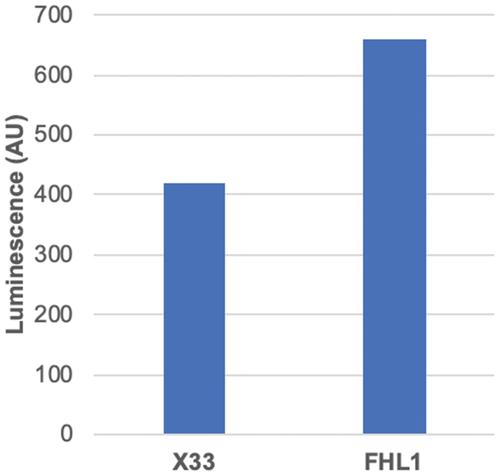Methods for Expression of Recombinant Proteins Using a Pichia pastoris Cell-Free System
Q1 Biochemistry, Genetics and Molecular Biology
Rochelle Aw, Alex J. Spice, Karen M. Polizzi
下载PDF
{"title":"Methods for Expression of Recombinant Proteins Using a Pichia pastoris Cell-Free System","authors":"Rochelle Aw, Alex J. Spice, Karen M. Polizzi","doi":"10.1002/cpps.115","DOIUrl":null,"url":null,"abstract":"<p>Cell-free protein synthesis is a powerful tool for engineering biology and has been utilized in many diverse applications, from biosensing and protein prototyping to biomanufacturing and the design of metabolic pathways. By exploiting host cellular machinery decoupled from cellular growth, proteins can be produced in vitro both on demand and rapidly. Eukaryotic cell-free platforms are often neglected due to perceived complexity and low yields relative to their prokaryotic counterparts, despite providing a number of advantageous properties. The yeast <i>Pichia pastoris</i> (also known as <i>Komagataella phaffii</i>) is a particularly attractive eukaryotic host from which to generate cell-free extracts, due to its ability to grow to high cell densities with high volumetric productivity, genetic tractability for strain engineering, and ability to perform post-translational modifications. Here, we describe methods for conducting cell-free protein synthesis using <i>P. pastoris</i> as the host, from preparing the cell lysates to protocols for both coupled and linked transcription-translation reactions. By providing these methodologies, we hope to encourage the adoption of the platform by new and experienced users alike. © 2020 The Authors.</p><p><b>Basic Protocol 1</b>: Preparation of <i>Pichia pastoris</i> cell lysate</p><p><b>Basic Protocol 2</b>: Coupled in vitro transcription and translation</p><p><b>Basic Protocol 3</b>: Determining luciferase production from cell-free protein synthesis reactions</p><p><b>Alternate Protocol 1</b>: Linked in vitro transcription and translation</p><p><b>Alternate Protocol 2</b>: Quantifying HSA protein concentration</p><p><b>Support Protocol 1</b>: Preparation of mRNA by in vitro transcription for linked transcription and translation</p>","PeriodicalId":10866,"journal":{"name":"Current Protocols in Protein Science","volume":"102 1","pages":""},"PeriodicalIF":0.0000,"publicationDate":"2020-10-27","publicationTypes":"Journal Article","fieldsOfStudy":null,"isOpenAccess":false,"openAccessPdf":"https://sci-hub-pdf.com/10.1002/cpps.115","citationCount":"7","resultStr":null,"platform":"Semanticscholar","paperid":null,"PeriodicalName":"Current Protocols in Protein Science","FirstCategoryId":"1085","ListUrlMain":"https://onlinelibrary.wiley.com/doi/10.1002/cpps.115","RegionNum":0,"RegionCategory":null,"ArticlePicture":[],"TitleCN":null,"AbstractTextCN":null,"PMCID":null,"EPubDate":"","PubModel":"","JCR":"Q1","JCRName":"Biochemistry, Genetics and Molecular Biology","Score":null,"Total":0}
引用次数: 7
引用
批量引用
Abstract
Cell-free protein synthesis is a powerful tool for engineering biology and has been utilized in many diverse applications, from biosensing and protein prototyping to biomanufacturing and the design of metabolic pathways. By exploiting host cellular machinery decoupled from cellular growth, proteins can be produced in vitro both on demand and rapidly. Eukaryotic cell-free platforms are often neglected due to perceived complexity and low yields relative to their prokaryotic counterparts, despite providing a number of advantageous properties. The yeast Pichia pastoris (also known as Komagataella phaffii ) is a particularly attractive eukaryotic host from which to generate cell-free extracts, due to its ability to grow to high cell densities with high volumetric productivity, genetic tractability for strain engineering, and ability to perform post-translational modifications. Here, we describe methods for conducting cell-free protein synthesis using P. pastoris as the host, from preparing the cell lysates to protocols for both coupled and linked transcription-translation reactions. By providing these methodologies, we hope to encourage the adoption of the platform by new and experienced users alike. © 2020 The Authors.
Basic Protocol 1 : Preparation of Pichia pastoris cell lysate
Basic Protocol 2 : Coupled in vitro transcription and translation
Basic Protocol 3 : Determining luciferase production from cell-free protein synthesis reactions
Alternate Protocol 1 : Linked in vitro transcription and translation
Alternate Protocol 2 : Quantifying HSA protein concentration
Support Protocol 1 : Preparation of mRNA by in vitro transcription for linked transcription and translation
利用毕赤酵母无细胞系统表达重组蛋白的方法
无细胞蛋白质合成是工程生物学的一个强大工具,已被用于许多不同的应用,从生物传感和蛋白质原型到生物制造和代谢途径的设计。通过利用与细胞生长分离的宿主细胞机制,可以在体外按需快速地生产蛋白质。真核无细胞平台往往被忽视,由于感知的复杂性和低产量相对于他们的原核同行,尽管提供了许多有利的性质。酵母毕赤酵母(也称为Komagataella phaffii)是一种特别有吸引力的真核宿主,可以产生无细胞提取物,因为它能够生长到高细胞密度,高容量生产力,菌株工程的遗传易感性,以及进行翻译后修饰的能力。在这里,我们描述了利用帕斯德酵母作为宿主进行无细胞蛋白合成的方法,从制备细胞裂解物到偶联和连锁转录-翻译反应的方案。通过提供这些方法,我们希望鼓励新用户和有经验的用户都采用这个平台。©2020作者。基本方案1:制备毕赤酵母裂解细胞基本方案2:耦合体外转录和翻译基本方案3:测定无细胞蛋白合成反应中荧光素酶的产生备选方案1:连接体外转录和翻译备选方案2:定量HSA蛋白浓度支持方案1:通过体外转录制备mRNA进行连接转录和翻译
本文章由计算机程序翻译,如有差异,请以英文原文为准。
来源期刊
期刊介绍:
With the mapping of the human genome, more and more researchers are exploring protein structures and functions in living organisms. Current Protocols in Protein Science provides protein scientists, biochemists, molecular biologists, geneticists, and others with the first comprehensive suite of protocols for this growing field.


 求助内容:
求助内容: 应助结果提醒方式:
应助结果提醒方式:


